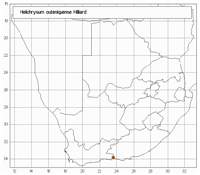Origin of name:
outeniquense refers to the Outeniqua Mountains in the Western Cape where the type has been collected
Diagnostic characters:
Medium sized headsBranched inflorescence on long stalk
Description:
Perennial herb or subshrub, branching from the base, stems c. 250 mm tall, thinly greyish-white woolly, leafy, becoming pedunculoid and nude near the heads. Leaves mostly 10�25 x 5�7 mm, elliptic-oblong becoming lanceolate towards the heads and passing rapidly into a few distant bracts, apex obtuse becoming acute in the uppermost leaves, base broad, half-clasping, both surfaces greyish-white woolly, glandular-setose as well. Heads homogamous, campanulate, c. 4 x 3 mm, 5 mm across the radiating bracts, many in small corymbose clusters arranged in a compact corymbose-panicle. Involucral bracts in c. 5 series, outermost short, pale fuscous, others subequal, scarcely exceeding the flowers, tips obtuse, opaque white, slightly crisped. Receptacle with short fimbrils. Flowers c. 20�25. Achenes not seen, ovaries with duplex hairs. Pappus bristles many, equaling corolla, tips barbellate, shaft scabrid, bases with patent cilia cohering strongly.
Flowering in January.
Distribution:
In valley near Joubertina in peaty soil near spring.
Fynbos Biome.
Notes:
Known only from the type collection. Allied to H. felinum but distinguished by its different habit, woollier leaves, and smaller heads with bracts in fewer series, arranged in a spreading corymbose panicle.
Taxonomy:
Literature:
Helichrysum outeniquense Hilliard in Flora of southern Africa 33,7 (2): 192 (1983).
Type:
Western Cape, Uniondale div., N. face of Outeniquas near Joubertina, Die Hoek, peaty soil near spring in valley, 15 i 1947, Esterhuysen 13632 (BOL, holo.).
Synonym(s):
Vouchers:
Esterhuysen13632 (BOL)
